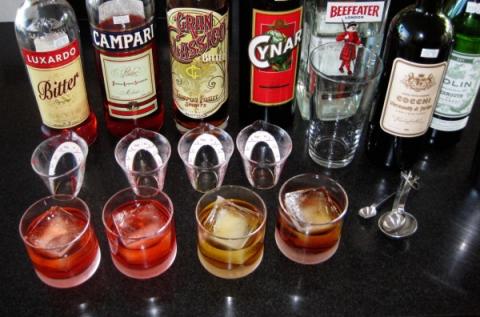
The Negroni is indomitable. Attack it with skewed ratios, and it rallies. Violate the ingredients, and it stubbornly persists. I can’t think of another drink that you can screw up so thoroughly and still enjoy the result.
This history of the Negroni is disputed, but probably dates to 1919, where the Americano was stiffened by substituting gin for the soda water. Regardless of exactly who created the drink and when, the Negroni is the King of bitter cocktails. If you spy a bottle of Campari on the backbar, the bartender probably knows how to make a Negroni.
Negroni
Stir, strain, rocks, lowball. Garnish with orange twist or flamed orange peel.
To challenge my ability to ruin a simple, innocent cocktail, I set about testing a variety of base amari:
- Campari – the gold standard, and the definitive choice
- Luxardo Bitter – the red, cheaper, harder-to-find alternative
- Gran Classico – the new Swiss entry with a distinctive profile and golden hue
- Cynar – the popular, brown distant cousin to Campari, included because it's awesome
First, an admission about sugar. I’ll happily drink a classic Negroni, but I find them sweeter than ideal. Two parts sweet ingredients to only one of spirit is pushing the limit for me, even with the bitter aspects to balance the sweetness. I prefer a less syrupy ratio, and have even gone so far as try other acidifiers, such as lime, citric acid, and Lactart. But certainly the easiest and most authentic way to tame sugarzilla is the perfect variant: split the sweet vermouth fraction into equal parts sweet and dry.
Normally I would have selected Punt e Mes as my preferred sweet vermouth. Some would classify this bitter oddity as a hybrid amaro / sweet vermouth, but I close my mind and try not to think about it. The stuff is just wonderful, so, yup, it’s just sweet vermouth. Alas, I was nearly out (oh dear). I opened a fresh bottle of Cocchi Vermouth di Torino, which I enjoy on its own merits. And a newish bottle of Dolin Dry served for the dry vermouth. I am also rather partial to Boissiere.
So my prototype recipe was:
2/3 oz Gin, Beefeater
2/3 oz Campari-like amaro
1/3 oz Sweet vermouth, Cocchi
1/3 oz Dry vermouth, Dolin
To minimize differences in dilution and stirring, I built each in a frozen glass with a huge very frozen ice cube, stirring each in several iterations.
I enlisted the help of my expert bitter snob (and spouse) and we started sampling.
Campari. The original, familiar. Bright citrus flavors. Instantly recognizable as Campari. As wonderful as you would expect it to be.
Luxardo Bitter. Quite similar to Campari really. Essentially the same (artificial) color. It has a floral aspect and is just enough different that I just don’t quite like it as well. In my area it is about 25-30% less expensive, but I would still pay the extra $8-$10 for Campari, even though I go through an astonishing amount of the stuff. Still, a worthy substitute.
Cin-Cyn
Stir and strain, or build. Squeeze one wedge and garnish with the other
Gran Classico. Interesting and quite different. Deeply floral with a spicy flavor. If you like Creme de Violette and Orange Flower Water, this might appeal to you. The golden color is natural and lovely. I enjoyed the variation, but mostly for the variety itself.
Cynar. The Gin-Cin-Cyn is essentially the same drink, and I certainly enjoy it. However in back-to-back sipping, it was thinner and less interesting than the original Negroni, which surprised me. Cynar (with a squeeze of lemon) is my go-to “I want something a little more” aperitif. I think it just couldn’t quite stand up to the other bold ingredients the way that Campari can.
So there you have it. All Negroni variations are good. But I like the original [P]erfect Negroni best. So far.
Dan Chadwick, Chief Swizzlestick